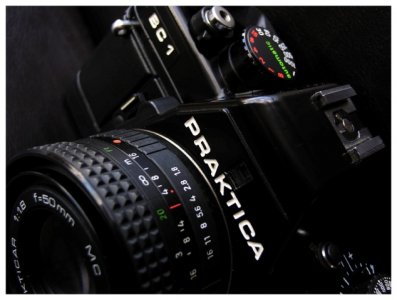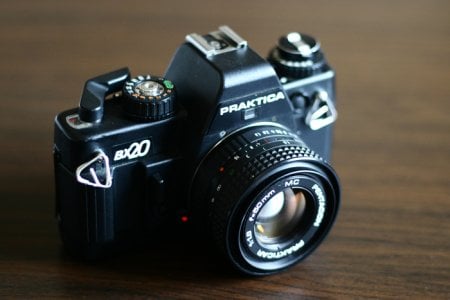das
Well-known
As they say, forbidden fruit often tastes the sweetest. As a fan of East German optics (mostly Carl Zeiss Jena), I, along with many others, fell down the M42 rabbit hole years ago. However, I always preferred the multicoated 1970s/80s CZJ lenses over the swirly, flare-y, yet pleasant at closer distances 1950s Biotars and Tessars. There are some real winners in the M42 CZJ MC line, like the Pancolars (50, 80), the Flektogon (35), and the Sonnars (135, 200). The only real drawback to many of these lenses was some pronounced barrel distortion at certain angles and distances. The color rendition and pastel-like effects they create are pretty incredible. It was a shame that these MC CZJ lenses were never really offered for sale in America at the height of 1970s and 1980s Cold War hysteria. At the same time, CZJ lenses were never cheap in the Eastern Bloc, so maybe there was a reason they were not exported in quantity to the West. If you bought any type of Praktica in the mid-1960s through the late 1980s in America, you were only going to get a standard Pentacon 50mm f/1.8 with retailers only offering Japanese-made M42 28s, 135s, etc., to supplement that German-made standard lens.
It seems that the real apex of the CZJ lens lineup came with the Praktica bayonet cameras, introduced in 1979. For a few years, CZJ re-popped their most popular M42 MC lenses into bayonet mount, while adding a 50mm f/1.4 (two versions), a 55mm f/2.8 macro (the only true macro produced in quantity by CZJ, with folks just using extension tubes on their Tessars beforehand), recalculated 200mm and 300mm lenses, etc. CZJ seems to have left the 35mm lens market by about 1984. While the B200 was a pretty cool camera for 1979, Pentacon was not ultimately able to keep up with the times. The BX20 and BX20s, although plasticky, are actually very nice and affordable aperture-priority autoexposure cameras with good viewfinder brightness. Pentacon also made any M42 adapter for them, which can be a little hard to find sometimes. The Pentacon-branded lenses made for the PB system were fairly hit or miss, with some being outsourced to Japan and South Korea. Most or all of the true Pentacon-made PB lenses were recycled M42 lenses.
I really like the BX20 and the CZJ lenses for it are fantastic and have a lot of character. I actually cannot remember ever seeing any of PB camera advertised for sale in America, in the 1990s at least. Maybe B&H had the 2001 BX20s for a time? Anyway, anyone else have any love for the PB system? This link is a fantastic resource for PB stuff: CZJ/PENTACON Prakticars by koji kawakami
It seems that the real apex of the CZJ lens lineup came with the Praktica bayonet cameras, introduced in 1979. For a few years, CZJ re-popped their most popular M42 MC lenses into bayonet mount, while adding a 50mm f/1.4 (two versions), a 55mm f/2.8 macro (the only true macro produced in quantity by CZJ, with folks just using extension tubes on their Tessars beforehand), recalculated 200mm and 300mm lenses, etc. CZJ seems to have left the 35mm lens market by about 1984. While the B200 was a pretty cool camera for 1979, Pentacon was not ultimately able to keep up with the times. The BX20 and BX20s, although plasticky, are actually very nice and affordable aperture-priority autoexposure cameras with good viewfinder brightness. Pentacon also made any M42 adapter for them, which can be a little hard to find sometimes. The Pentacon-branded lenses made for the PB system were fairly hit or miss, with some being outsourced to Japan and South Korea. Most or all of the true Pentacon-made PB lenses were recycled M42 lenses.
I really like the BX20 and the CZJ lenses for it are fantastic and have a lot of character. I actually cannot remember ever seeing any of PB camera advertised for sale in America, in the 1990s at least. Maybe B&H had the 2001 BX20s for a time? Anyway, anyone else have any love for the PB system? This link is a fantastic resource for PB stuff: CZJ/PENTACON Prakticars by koji kawakami
D
Deleted member 82967
Guest
With film, I only had a Praktica MTL-3 plus a CJZ 50mm M42 Pancolor plus a 28mm of some sort and I did long for a bayonet-mount.
With digital, I'm all bayonet-mount but curiously have a few M42 lenses and the necessary adapters!
With digital, I'm all bayonet-mount but curiously have a few M42 lenses and the necessary adapters!
johnf04
Well-known
Pentacon were early users of plastics in cameras - the L series, from 1969, had chromed plastic top and bottom plates, although little else in the cameras was plastic. The shutter used in the PB is quite different to the L series unit. The L series shutter has the mechanism hung from a single plate - the camera body forms the back. The timing module is under the top plate.
The PB shutter is more like the Copal Square shutter used in Japanese cameras, with the mechanism between two plates, and the timing module on the front.
The PB shutter is more like the Copal Square shutter used in Japanese cameras, with the mechanism between two plates, and the timing module on the front.
das
Well-known
I always wondered if Pentacon outsourced the PB shutter.Pentacon were early users of plastics in cameras - the L series, from 1969, had chromed plastic top and bottom plates, although little else in the cameras was plastic. The shutter used in the PB is quite different to the L series unit. The L series shutter has the mechanism hung from a single plate - the camera body forms the back. The timing module is under the top plate.
The PB shutter is more like the Copal Square shutter used in Japanese cameras, with the mechanism between two plates, and the timing module on the front.
johnf04
Well-known
The Copal shutter has a different arrangement of rivetted arms controlling the shutter blades, and the PB shutter I have (from a B200) is larger than the Copal, and has an eyepiece shutter. I think the PB shutter is a development of the earlier L series - it is similar in size.I always wondered if Pentacon outsourced the PB shutter.
JeffS7444
Well-known
Here's my Jenaflex AM-1, which is a special edition of the Praktica B200, commemorating the 50th anniversary of Carl Zeiss in Jena. I got it cheaply because it had suffered some battery leakage, the self-timer had jammed, and the top cover was cracked. I opted to leave my repairs visible on the top cover, might eventually embellish it with powdered gold. Haven't used it extensively, but the last time I went out with the camera set to Automatic, and parked the lens's aperture to f/6.3 or thereabouts, I got good results. Had it been readily available in the USA when new, I think it might've been reasonably competitive.
Biggest problem for me acquiring a Praktica BX20 or BX20s is that most seem to be located in Germany or the UK: Once the cost of shipping to the USA is figured in, they are kind of pricey.
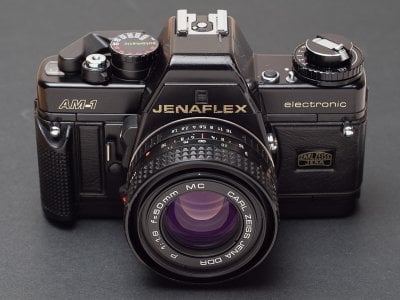
Biggest problem for me acquiring a Praktica BX20 or BX20s is that most seem to be located in Germany or the UK: Once the cost of shipping to the USA is figured in, they are kind of pricey.

Last edited:
santino
FSU gear head
I always wondered if Pentacon outsourced the PB shutter.
The shutter is a genuine development of Praktica but the electronics in the B200 were produced in Japan. Later B-series cameras use east german electronics. Check out the Praktica Ee2 (L-series), it already had east german electronics and therefore was kinda big. In order to build a small camera with aperture priority Pentacon bought the electronics from Japan, because back then they were not able to produce electronics that small.
p.giannakis
Pan Giannakis
I got my first ever real camera in 1991 when Pentacon was closing down and all models we sold at half price. I got a spanking clean brand new Praktica BMS with the 50f/1.7 and a few years later added a 28f/2.8 and a Praktica 28-70. I was very proud of my combo and run hundreds of slides through it the 90s.
Eventually the dirt and grime started building up on the lens/mount contacts and started experiencing the Xmas tree lights syndrome in the viewfinder and the shutter developed what I call "typical Praktica shutter error " that is, if left unused for a few hours/days, the first frame the camera will shoot at 1sec no matter what speed you select. This error developed at almost all Prakticas I got my hands on.
Out of all Praktica-B cameras, the B200 was probably the most reliable I ever came across. My BMS died 6 years later having treated it like a jewel. Lenses were better than the cameras, my slides prove this in my mind. I would pick a BMS and fall in love again every time I look through the viewfinder but I know that they are not reliable.
Me in 1992 with my BMS
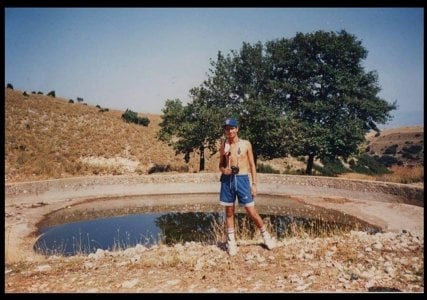
Eventually the dirt and grime started building up on the lens/mount contacts and started experiencing the Xmas tree lights syndrome in the viewfinder and the shutter developed what I call "typical Praktica shutter error " that is, if left unused for a few hours/days, the first frame the camera will shoot at 1sec no matter what speed you select. This error developed at almost all Prakticas I got my hands on.
Out of all Praktica-B cameras, the B200 was probably the most reliable I ever came across. My BMS died 6 years later having treated it like a jewel. Lenses were better than the cameras, my slides prove this in my mind. I would pick a BMS and fall in love again every time I look through the viewfinder but I know that they are not reliable.
Me in 1992 with my BMS

p.giannakis
Pan Giannakis
Aha ! That might explain my experience.The shutter is a genuine development of Praktica but the electronics in the B200 were produced in Japan. Later B-series cameras use east german electronics.
JeffS7444
Well-known
Ahh, that explains it: I had been surprised to see more modern details, such as a surface-mounted IC, as opposed to the older DIP-style as found in Lomo LC-A.The shutter is a genuine development of Praktica but the electronics in the B200 were produced in Japan. Later B-series cameras use east german electronics. Check out the Praktica Ee2 (L-series), it already had east german electronics and therefore was kinda big. In order to build a small camera with aperture priority Pentacon bought the electronics from Japan, because back then they were not able to produce electronics that small.
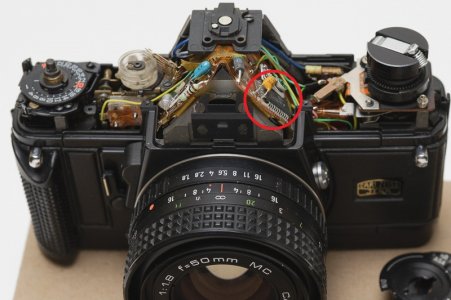
JeffS7444
Well-known
das
Well-known
That 50mm f/1.8 CZJ Pancolar is a beautiful lens. I have been itching to replace my PB Pentacon 50mm f/1.8 with it but I already have one in M42 mount. I usually use the 55mm macro as the "standard" lens. It's also very wonderful. Took me a long time to find one as not many were made. I like the BX20 over the BX20s solely for the reason that the latter uses DX coding and only has manual ASA override from 25-400. That was a big mistake imho on the BX20s. Also, having the ability to use Olympus TTL flashes is also kind of cool, although I have never tried one.
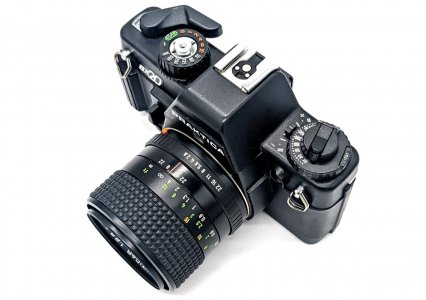

Last edited:
das
Well-known
I had an EE2, and was excited about the aperture priority AE, but the East German electronics failed soon after I started using it.The shutter is a genuine development of Praktica but the electronics in the B200 were produced in Japan. Later B-series cameras use east german electronics. Check out the Praktica Ee2 (L-series), it already had east german electronics and therefore was kinda big. In order to build a small camera with aperture priority Pentacon bought the electronics from Japan, because back then they were not able to produce electronics that small.
p.giannakis
Pan Giannakis
santino
FSU gear head
IMO the Praktica is THE european SLR, only contested by the Exakta. I know, there’s the Leicaflex, Contax, Praktina etc. but the Prakticas were the only quality competitor to relatively inexpensive japanese SLRs. They had through the lens metering (some models even at open aperture) and metal blade shutters. The B series even added a bayonet mount and backwards compatibility to M42 lenses (at working aperture). Even when the russians/germans invented the SLR, its the japanese who reinvented them with great success. When it comes to SLRs and Germany, its the east that was more successful than the west 😁
robertofollia
Established
I has a MTL5B from 1988 but in summer 1991 I got the BX20, a dream come true. I had been drooling over this camera for years, since I first saw it in the mid-80s. In Spain it was not available until 1990-91, well after the wall's demise.
Ergonomically wise it was perfect. I can't recall to this day a better viewfinder arrangement for left-eye shooters who use glasses. All shtter speeds displaying clearly in viewfinder plus aperture window as well. Film advance reminder by means of an orange filter in aperture window.
Had only 2 failures: Shutter release button not disconnecting and draining batteries and film advance not locking (so wasting 3 exposures for 1 shot). Repaired under warranty. Instead of a body replacement was repaired. I still keep it and still works.
I can recall that the shutter was different from that of the rest of B-series cameras. The chassis is also different to Bs and BMS
I remember to have shot dozens (or maybe hundreds) of rolls until it was replaced in 1995 with the contax S2 which is my avatar. Worse visibility in viewfinder and a step back in ergonomics by comparison to the BX20.
The shutter action was quite crude but never got a blurry shot. I took it skiing, took it to Moscow and St Petersburg with freezing temperatures. Took it in the backpack when doing motorbike Trials in the mountains. Never missed a beat..
It was a pity Pentacon Dresden camera division collapsed because the BX20 was a superb camera and who knows what other great designs could have come from Dresden.
The only similar camera to the BX20 in terms of ergonomics is the Leica R7. The R8-9 is also great rgonomically but too heavy for me.
Best regards
Ergonomically wise it was perfect. I can't recall to this day a better viewfinder arrangement for left-eye shooters who use glasses. All shtter speeds displaying clearly in viewfinder plus aperture window as well. Film advance reminder by means of an orange filter in aperture window.
Had only 2 failures: Shutter release button not disconnecting and draining batteries and film advance not locking (so wasting 3 exposures for 1 shot). Repaired under warranty. Instead of a body replacement was repaired. I still keep it and still works.
I can recall that the shutter was different from that of the rest of B-series cameras. The chassis is also different to Bs and BMS
I remember to have shot dozens (or maybe hundreds) of rolls until it was replaced in 1995 with the contax S2 which is my avatar. Worse visibility in viewfinder and a step back in ergonomics by comparison to the BX20.
The shutter action was quite crude but never got a blurry shot. I took it skiing, took it to Moscow and St Petersburg with freezing temperatures. Took it in the backpack when doing motorbike Trials in the mountains. Never missed a beat..
It was a pity Pentacon Dresden camera division collapsed because the BX20 was a superb camera and who knows what other great designs could have come from Dresden.
The only similar camera to the BX20 in terms of ergonomics is the Leica R7. The R8-9 is also great rgonomically but too heavy for me.
Best regards
santino
FSU gear head
The only thing that bothers me in the Bx20 is that loud „bang“ at the the end of the cocking the shutter/advancing the film cycle. That is why I believe, that the shutter is somehow different from the earlier B series. Other than that it is a great, relatively inexpensive camera with a „hidden“ dof preview button 😉
das
Well-known
I read that at the end Pentacon was working on an autofocus camera system that did not quite make production. For me, the BX20 is a fine manual focus camera body. However, the CZJ lenses are the real draw. In my opinion, there is nothing quite like them in terms of overall character plus performance in any other 1980s/90s manual focus system.
ChrisPlatt
Thread Killer
I just bought a nice Praktica B200 from Camera House in UK.
I wanted a reliable body for use with my B-mount 35/2.4 Prakticar (Flektogon) lens.
Later BC1 and BX20 bodies I purchased failed rather quickly.
Chris
I wanted a reliable body for use with my B-mount 35/2.4 Prakticar (Flektogon) lens.
Later BC1 and BX20 bodies I purchased failed rather quickly.
Chris
santino
FSU gear head
If you want to travel light and small, make sure to get the 50 2.4 Prakticar pancake lens. It is a decent performer and really compact.
Share:
-
This site uses cookies to help personalise content, tailor your experience and to keep you logged in if you register.
By continuing to use this site, you are consenting to our use of cookies.



